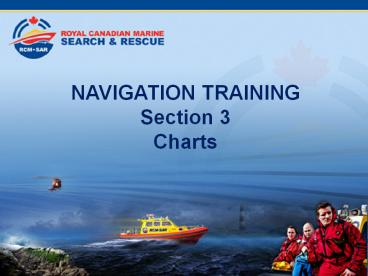NAVIGATION TRAINING Section 3 Charts - PowerPoint PPT Presentation
Title:
NAVIGATION TRAINING Section 3 Charts
Description:
NAVIGATION TRAINING Section 3 Charts Table of Contents Section 1 Types of Navigation Section 2 Terrestial Coordinates Section 3 Charts Section 4 ... – PowerPoint PPT presentation
Number of Views:1509
Avg rating:3.0/5.0
Title: NAVIGATION TRAINING Section 3 Charts
1
NAVIGATION TRAINING Section 3 Charts
2
Table of Contents
- Section 1 Types of Navigation
- Section 2 Terrestial Coordinates
- Section 3 Charts
- Section 4 Compass
- Section 5 Nautical Publications
- Section 6 Navigational Aids
- Section 7 Buoyage
- Section 8 Position Lines and Fixes
- Section 9 Tides
- Section 10 Currents
- Section 11 Weather
3
Charts
4
Charts
Mercator Projection All coastal charts of
Vancouver Island, northern coasts of BC, Georgia
Strait and ports are Mercator Charts.
5
Charts
Mercator Projection ADVANTAGES Position,
distance, and direction can be accurately
measured True shape of features is maintained
over small areas
6
Charts
Chart Scale The relationship between two
measurements. Expressed as a ratio. The scale
to which a chart is drawn appears directly under
its title.
7
Charts
- Chart Scale
- Large scale chart covers a small area and are
used for piloting and inshore navigation. - Small scale charts are less detailed than large
scale charts and cover a large area.
8
Charts
Chart Production The Canadian Hydrographic
Service is responsible for all Canadian Charts
and Publications. See www.charts.gc.ca
9
Charts
Types of Charts Coastal charts Large Scale
Charts 150,000 - 1150,000 For approaching
bays and harbours, and used for coastal
navigation showing outlying reefs and shoals.
10
Charts
Plotting a Position 1. Determine the parallels
on the chart that bracket the latitude. 2.
Place the pivot point of the compass on the
closest line.
11
Charts
Plotting a Position 3. Spread the compass
until the lead rests on the given latitude. 4.
Move to the approximate longitude and swing an
arc.
12
Charts
Plotting a Position 5. The same process is
repeated using the longitude scale and the given
longitude. 6. The desired position is the
intersection of these two arcs.
13
Charts
Plotting a Position 7. If plotted correctly,
the intersection should occur at the crest of
both arcs.
14
Charts
Measuring Distance The latitude scale can be
used to measure distances, since one degree of
latitude equals 60 nautical miles, everywhere on
the earth.
15
Charts
Measuring Direction All rhumb lines on a
Mercator projection represent true directions.
Measurement of direction on a Mercator chart is
accomplished by using a parallel ruler to
transfer the direction of a rhumb line to a
nearby compass rose.
16
Charts
Measuring Direction
045 True 060 Magnetic
17
Charts
Correction of Charts The Canadian
Hydrographer issues weekly Notices to Mariners,
which include corrections to be made to Canadian
charts. When charts are bought, they are
generally corrected up to date. Once in use
Notices to Mariners should be checked and
corrections to charts made as necessary.
18
Charts
Correction of Charts When a correction has
been made, a note of the year and Notice to
Mariner number should be made in the bottom left
hand corner of the chart, having checked that the
previous correction has been made. 2008 - 41-
74 - 86 - 127































